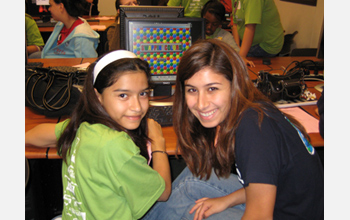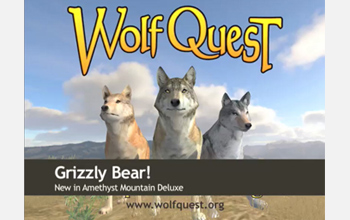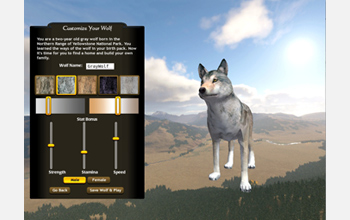All Images


Press Release 08-147
Real-World Lessons in Virtual World

Designing and playing computer games can engage students in science and mathematics
Back to article | Note about images
 |
A high-school student demonstrates a game she developed, and solicits feedback from a middle-school student. In this game, players work with colored balls that fall from above. Each ball displays a math problem and the object of the game is to move around the buckets at the bottom of the screen to match the problem to its correct answer.
Credit: Girlstart, Inc. |
Download the high-resolution JPG version of the image. (1.8 MB)
|
Use your mouse to right-click (or Ctrl-click on a Mac) the link above and choose the option that will save the file or target to your computer.
|
 |
 View video View video
With WolfQuest, an interactive computer game, players are immersed in every aspect of a wolf's survival in its habitat.
Credit: Minnesota Zoo and eduweb
|
 |
'Take it Global' is the showcase in which students involved in IT Girl demonstrated their games to a wider audience. The event was held at Silicon Labs in Austin, Texas.
Credit: Girlstart, Inc. |
Download the high-resolution JPG version of the image. (171 KB)
|
Use your mouse to right-click (or Ctrl-click on a Mac) the link above and choose the option that will save the file or target to your computer.
|
 |
WolfQuest allows players to customize their wolf avatars.
Credit: Minnesota Zoo and eduweb |
Download the high-resolution JPG version of the image. (440 KB)
|
Use your mouse to right-click (or Ctrl-click on a Mac) the link above and choose the option that will save the file or target to your computer.
|
 |
WolfQuest players must learn how to track and kill elk. A wolf's energy is best spent working in packs and attacking animals other than healthy bulls.
Credit: Minnesota Zoo and eduweb |
Download the high-resolution JPG version of the image. (892 KB)
|
Use your mouse to right-click (or Ctrl-click on a Mac) the link above and choose the option that will save the file or target to your computer.
|
 |
In LunarQuest, players interact with an environment that includes a dome-topped city on the surface of the moon.
Credit: Janis Cannon-Bowers, I.S.T., University of Central Florida |
Download the high-resolution JPG version of the image. (302 KB)
|
Use your mouse to right-click (or Ctrl-click on a Mac) the link above and choose the option that will save the file or target to your computer.
|
 |
LunarQuest's mailbots are robots that are programmed to deliver the mail to lunar colonists. When the mailbots start getting lost, a mini-game challenges students to reprogram them, applying the principles of vectors.
Credit: Janis Cannon-Bowers, I.S.T., University of Central Florida |
Download the high-resolution JPG version of the image. (504 KB)
|
Use your mouse to right-click (or Ctrl-click on a Mac) the link above and choose the option that will save the file or target to your computer.
|
|









